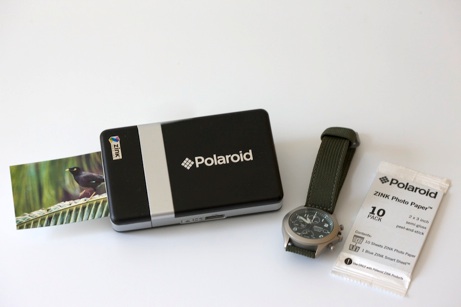Polaroid POGO Printer

Since the days... of the Polaroid, I have always been looking for a solution that would enable me to print pictures in the field. I have found it important to share my work with the people helping me and to be able to give away prints of pictures just taken makes everybody feel more like something has been achieved. I bought a very nice Canon Selphy ES1 because it was completely self-contained and I am perfectly happy with it but I found that airline luggage weight limitations always prevented me from taking it with me. On a couple of occasions, I actually bought a cheap printer on site which I gave away when leaving. Both solutions are still impractical but I am now exploring a new one.
Polaroid, which went bankrupt a few years back, is still around as a brand name and some of its research managed to jump ship on time. One of these most interesting offsprings is Zink, a company formed around the discovery of a new printing system: Zero Ink. Zero Ink means just that: their printers only need paper, no ink. In fact, it is a very clever thermal paper, with coloured ink embedded in crystals that react to different temperatures but it is still only paper and it makes the operation of the printers extremely simple and the cost of operation perfectly transparent.
Their first product, marketed by Polaroid and called the Pogo, is an absolutely tiny, entirely self-contained printer primarily meant for direct camera and cellphone use. It has an USB port but only to connect directly to a PictBridge camera and it has BlueTooth, enabling it to be recognised by most phones and printed to. Interestingly, and the information only appeared recently, the Bluetooth “send file” command will work from any computer as long as the file is a JPEG. That, of course is what I was waiting for. Sadly, the iPhone is one of the few incompatible devices.
The drawbacks are few but one is significant. The pictures are credit card sized, which limits their applications but it was difficult to expect more from a palm sized machine. They are adhesive, which is useful as they are easy to mount on card to make a more significant present. The paper is not too expensive, at about 20p a sheet, and fairly available. Being created thermally, the prints are unlikely to be permanent but my short experience shows them to be quite resilient, especially to scratching. The only real drawback is the battery life of the device, at best 15 pictures, and the relatively large AC charger that accompanies it. The battery can be changed and is available as a spare for £20 but it wouldn’t have been difficult to make it a bit larger and have given the device a better autonomy.
I have taken the Pogo with me occasionally when I thought you could only print to it from a camera but now that I have discovered the way to print directly from my MacBook, I am going to take it with me systematically and give it a proper field testing. It certainly fills a niche that has been completely empty so far.
5 December 2008
